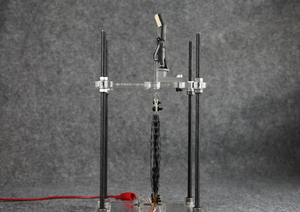Design of a High-Speed Prosthetic Finger Driven by Peano-HASEL Actuators
2020
Article
rm
Current designs of powered prosthetic limbs are limited by the nearly exclusive use of DC motor technology. Soft actuators promise new design freedom to create prosthetic limbs which more closely mimic intact neuromuscular systems and improve the capabilities of prosthetic users. This work evaluates the performance of a hydraulically amplified self-healing electrostatic (HASEL) soft actuator for use in a prosthetic hand. We compare a linearly-contracting HASEL actuator, termed a Peano-HASEL, to an existing actuator (DC motor) when driving a prosthetic finger like those utilized in multi-functional prosthetic hands. A kinematic model of the prosthetic finger is developed and validated, and is used to customize a prosthetic finger that is tuned to complement the force-strain characteristics of the Peano-HASEL actuators. An analytical model is used to inform the design of an improved Peano-HASEL actuator with the goal of increasing the fingertip pinch force of the prosthetic finger. When compared to a weight-matched DC motor actuator, the Peano-HASEL and custom finger is 10.6 times faster, has 11.1 times higher bandwidth, and consumes 8.7 times less electrical energy to grasp. It reaches 91% of the maximum range of motion of the original finger. However, the DC motor actuator produces 10 times the fingertip force at a relevant grip position. In this body of work, we present ways to further increase the force output of the Peano-HASEL driven prosthetic finger system, and discuss the significance of the unique properties of Peano-HASELs when applied to the field of upper-limb prosthetic design. This approach toward clinically-relevant actuator performance paired with a substantially different form-factor compared to DC motors presents new opportunities to advance the field of prosthetic limb design.
| Author(s): | Zachary Yoder and Nicholas Kellaris and Christina Chase-Markopoulou and Devon Ricken and Shane K Mitchell and Madison B Emmett and Jacob Segil and Christoph Keplinger |
| Journal: | Frontiers in Robotics and AI |
| Volume: | 7 |
| Pages: | 586216 |
| Year: | 2020 |
| Month: | November |
| Day: | 27 |
| Publisher: | Frontiers |
| Department(s): | Robotic Materials |
| Bibtex Type: | Article (article) |
| Paper Type: | Journal |
| DOI: | 10.3389/frobt.2020.586216 |
| URL: | https://www.frontiersin.org/articles/10.3389/frobt.2020.586216/full? |
| Additional (custom) Fields: | |
| conflict_of_interest: | NK, SKM, and CK are listed as inventors on patent applications PCT/US18/023797 and PCT/US19/020568 that cover fundamentals and basic designs of HASEL actuators. NK, SKM, and CK are co-founders of Artimus Robotics, a start-up company commercializing electrohydraulic HASEL actuators. The remaining authors declare that the research was conducted in the absence of any commercial or financial relationships that could be construed as a potential conflict of interest. |
| acknowledgments: | The authors would like to thank Dr. Sean Humbert for the use of high-speed camera equipment used in the characterization of Peano-HASEL actuators (Phantom v710 and high-power tungsten flood lights). |
|
BibTex @article{Keplinger20-FRAI-Desing,
title = {Design of a High-Speed Prosthetic Finger Driven by Peano-HASEL Actuators},
author = {Yoder, Zachary and Kellaris, Nicholas and Chase-Markopoulou, Christina and Ricken, Devon and Mitchell, Shane K and Emmett, Madison B and Segil, Jacob and Keplinger, Christoph},
journal = {Frontiers in Robotics and AI},
volume = {7},
pages = {586216},
publisher = {Frontiers},
month = nov,
year = {2020},
doi = {10.3389/frobt.2020.586216},
url = {https://www.frontiersin.org/articles/10.3389/frobt.2020.586216/full?},
month_numeric = {11}
}
|
|




